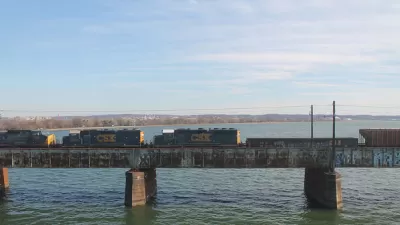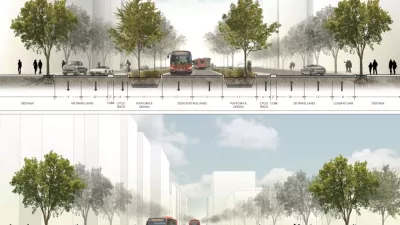In anticipation of the expected opening of the H Street/Benning Road streetcar line in Washington, D.C., Peter Dovak examines the evolution of streetcar planning over the past 20 years.
According to Peter Dovak, "[y]ou can trace plans for modern streetcar service in the District back to the Transportation Vision, Strategy and Action Plan, which the District Department of Public Works completed in March of 1997. This plan identified a need for better inter-District transit to complement the Metro, and it proposed three possible streetcar lines to make that happen."
Since then the Washington Metropolitan Area Transit Authority has completed two studies, one in 1999 and another in 2002, recommending three and then four, respectively, possible streetcar lines "as part of a larger region-wide transit vision." The District Department of Transportation has also completed a number of studies under the DC's Transit Future program, including 2005's DC's Transit Future System Plan and Alternatives Analysis, which has subsequently been updated and expanded several times. The article includes links to all of the relevant studies, programs, and plans in the chronology.
Recent political winds and funding shortages have pared away the most robust proposals contained in these plans, and Dovak speculates that the success of the H Street/Benning Road streetcar line could determine the fate of gander visions for a streetcar network in and around the nation's capital. Dovak also promises a forthcoming series of articles examining the modern streetcar proposals in Northern Virginia and the two routes under construction in Washington, D.C.
FULL STORY: A history of streetcar planning in the District

Study: Maui’s Plan to Convert Vacation Rentals to Long-Term Housing Could Cause Nearly $1 Billion Economic Loss
The plan would reduce visitor accommodation by 25,% resulting in 1,900 jobs lost.

North Texas Transit Leaders Tout Benefits of TOD for Growing Region
At a summit focused on transit-oriented development, policymakers discussed how North Texas’ expanded light rail system can serve as a tool for economic growth.

Using Old Oil and Gas Wells for Green Energy Storage
Penn State researchers have found that repurposing abandoned oil and gas wells for geothermal-assisted compressed-air energy storage can boost efficiency, reduce environmental risks, and support clean energy and job transitions.

Private Donations Propel Early Restoration of Palisades Playground
Los Angeles has secured over $1.3 million in private funding to restore the Pacific Palisades playground months ahead of schedule, creating a modern, accessible space that supports community healing after recent wildfires.

From Blight to Benefit: Early Results From California’s Equitable Cleanup Program
The Equitable Community Revitalization Grant (ECRG) program is reshaping brownfield redevelopment by prioritizing projects in low-income and environmental justice communities, emphasizing equity, transparency, and community benefits.

Planting Relief: Tackling Las Vegas Heat One Tree at a Time
Nevada Plants, a Las Vegas-based nonprofit, is combating the city’s extreme urban heat by giving away trees to residents in underserved neighborhoods, promoting shade, sustainability, and community health.
Urban Design for Planners 1: Software Tools
This six-course series explores essential urban design concepts using open source software and equips planners with the tools they need to participate fully in the urban design process.
Planning for Universal Design
Learn the tools for implementing Universal Design in planning regulations.
Ascent Environmental
Borough of Carlisle
Institute for Housing and Urban Development Studies (IHS)
City of Grandview
Harvard GSD Executive Education
Toledo-Lucas County Plan Commissions
Salt Lake City
NYU Wagner Graduate School of Public Service




























